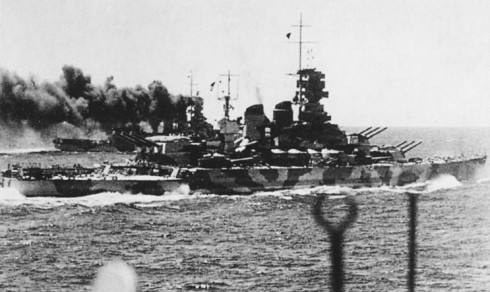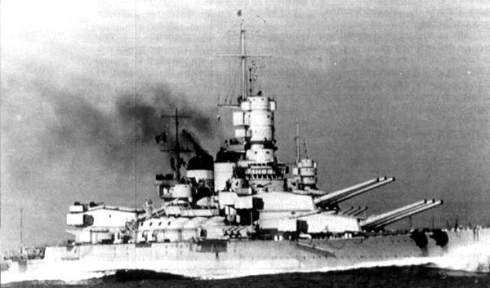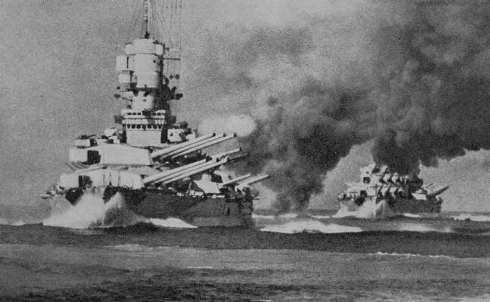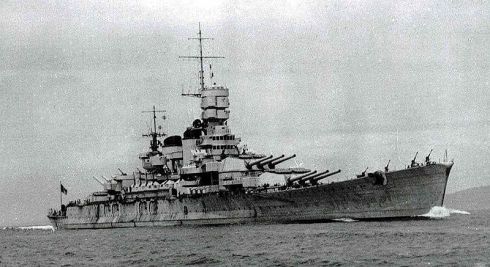When most people think of battleships in action during World War II certain events come to mind: The Battle of the River Plate, the hunt to sink the Bismark, the battles around Savo Island, The Battle of the Surigao Straight and the death ride of the Yamato. While the Italian Navy (Regia Marina) didn’t take part in any of these actions, they did go toe to toe with British battleships and their presence kept numerous Italian convoys safe from British surface ships when the Royal Navy was on the ropes in 1941. Italy in fact, fielded seven battleships during the war the last three being part of the Littorio class, among the finest battleships ever built.
In the Mid-1930’s Italy began a major reconstruction of its battleships. Two ships each of the Cavour and Duilio class emerged from the yards as nearly new ships with upgraded power plants, armor, and torpedo protection. Now the Italian’s had far more useful battleships than they had previously, but they were costly conversions and still had much smaller guns (12.6-inch) than their British contemporaries ( mostly 15-inch) and were less well armored. They did appear superior to France’s Courbet and Bretagne class battleships. This gave Italy a one up on France at least, which was her nearest naval adversary. That was until France laid down her Dunkerque class fast battleships which had superior guns, speed and much better armor. Italy was quick to counteract.
Italy immediately set out to counter the Dunkerques with a bigger, better battleship. Italy (as well as the US, UK, Japan, and France) was a signatory of the Washington Naval treaty which restricted the displacement and armament size of new battleships. Italy designed a ship to the maximum standards allowed by the treaty and aimed to build a ship of approx. 35,000 tons with nine 15-inch. guns in three triple turrets, a powerful secondary armament, up to the date armor and torpedo protection and a speed of around 30kts.
Main Armament
The size of the main guns set at 15 in. The Washington Naval Treaty allowed the Italians to build a gun with a maximum caliber of 16 inches. This would have had to have been designed from scratch and it would have been extremely difficult for Italian industry to fabricate a new weapon that large. Luckily for the Navy they had already developed a 15-inch gun for the canceled Caracciolo class battleships. By using that design as a starting point the navy could produce a gun far faster than if a 16-inch gun were to have been designed from scratch. The resulting Model 1934 15″/50 gun was one of the most powerful naval guns ever produced. It also had the longest range of all battleship guns, even though the turret possessed only average elevation. These guns contained two striking deficiencies though; due to the high pressures and power produced by these guns the barrel life was only110-130 rounds, less than half that of their contemporaries. They also suffered from chronic shell dispersion due to poorly fabricated ordnance (the gun’s accuracy was excellent with properly manufactured shells).
Secondary Armament
The French navy fielded very large and heavily armed destroyers in the 1930s. So the Italian’s decided that a powerful secondary armament was needed to keep them at a distance. A 6″/55 weapon was chosen and mounted in four triple turrets, two forward and two aft on the beams, near the main turrets. Sources conflict on whether these guns suffered from dispersion of not. These were single purpose weapons, only suitable against low angle targets, so a separate anti-aircraft suite had to be mounted as well.
Anti aircraft protection was provided in the form of twelve Model 1939 3.5″/55 guns in single, power operated turrets, grouped amidships and arranged six a piece port and starboard. This gun had great potential and could have been an excellent anti aircraft gun, but was plagued by a complicated and delicate gyro stabilized mounting. They broke down frequently and had troublesome electronics. It remains one of the more ingenious pieces of Italian ordnance.
Light AA was provided by 37mm guns and 20mm cannon. The 37mm/54 came in several mountings, some were water cooled while, some were air cooled. It was a reliable weapon but lacked the range, ceiling and muzzle velocity of similar guns like the 40mm Bofors. The 20mm gun was an interesting design that fed its spent casings back into its magazines. While reliable, it was fed from 12 round mags that needed to be changed constantly and lowered the firing rate. The same problem plagued the Japanese navy’s 25mm Type 96.
Armor Protection
The Littorio’s possessed very good armor protection for their day. First there was an external belt of 2.8″ thickness (a.k.a. a decapping plate) to reduce the effectiveness of the armor piercing shells. This was followed by the 11″ main belt sloped inwards at 14 degrees tapering off at the ends. Behind the main belt was 50mm of wood backing, a 25mm splinter plate, an air gap and lastly another 35mm splinter plate. All of this was designed to be able to stop a 15-inch projectile at 17,50oyds.
The Magazines were protected by 162mm thick roofs with bulkheads ranging from 100mm-210mm in thickness. The barbettes for the 15-inch guns ranged from 350 above the forecastle to 280 below it. The turrets were 350mm at their faces and 200mm at their sides. The 6-inch guns were 280mm on their faces, 150mm at the roof, sides at 75mm-130mmwith barbettes ranging from 100mm-150mm in thickness. This is arguably the best protected secondary armament ever mounted aboard a battleship. Why it was so extensive I’m unaware of, perhaps to ensure their utility against France’s large destroyers?
Vertical protection was somewhat weak. The deck was 100mm thick with 36mm and 12mm splinter plates between decks. This is much thinner than French and British battleships of the same era. It also made the Littorio’s very vulnerable to high angle fire, and may explain Roma’s loss to a Fritz-X AP glider bomb.
Torpedo protection was provided by Pugliese cylinders. These cylinders were located internally below the armor belt, between the side of the ship and the bulkheads. The cylinders were kept empty and the space around it was filled with fuel oil and water. The idea was that upon being hit by a torpedo the empty cylinder would absorb the impact of the explosion and be crushed, keeping the shock affects away from the ship’s innards. Problems with this system were that it provided an insufficient crush zone and suffered from poorly welded seems which reduced their effectiveness.
Other Details
One thing that is apparent on first viewing the Littorios is that they are very well balanced looking ships with uncomplicated superstructures, unlike for example, the Bismarck or South Dakota class battleships. The ship was commanded by a nine level armored conning tower that contained a separate captain’s and admiral’s bridge. Mounted on top of this were two large range finders, the lower equipped with a stereoscopic type for the admiral’s usage, while the upper range finding was fitted with both stereoscopic and coincidence types. All three units of the Littorio class were fitted with EC. 3 Gufo (owl) radar.
The Littorios were equipped with 8 Yarrow type boilers, powering 4 groups of Belluzzo single reduction geared turbines on 4 shafts turning 4, 3 bladed screws. This allowed the Littorios to make 31 knots on trials with 28-29kts being the norm once in service. An interesting feature about these ships was that they were fitted out with three rudders. A single main rudder was equipped well aft between the screws while two smaller auxiliary rudders were located behind the port and starboard wing screws. All three rudders could operate independently.
These ships were equipped with a single pneumatic catapult with accompanying crane to handle up three Ro. 43 reconnaissance aircraft. Later on, one of the Ro. 43s was landed and replaced with a RE. 2000 fighter. The RE.2000 was a land based fighter and once launched, it could not be recovered, it had to find a land base, or ditch near the ship. This concept is the Catapult Armed Merchantmen used by the British, in that they used Hurricane fighters launched from mountings on the stern.
In all, three ships were built and entered service; the Littorio (Italia), the Vittorio Veneto, and the Roma. A fourth unit the Impero was laid down but never finished due to the changing demands of the war.
Service History
By the time the Italian navy entered the war France had surrendered, its fleet moored in Toulon not sure of what to do. This left only the British Mediterranean fleet based out of Alexandria and Force H operating out of Gibraltar to contend with. Being that neither of these fleets operated together it gave the Italians a level of numerical superiority. Unfortunately for the Italians, the British were quick to rectify that. On the night of of 11-1 2 November 1940, the British aircraft carrier HMS Illustrious launched an air strike on the main Italian fleet based at Taranto. Littorio was present and was struck by three torpedoes, one on the port side very far aft, and two on the starboard side in between the main guns and forward of “A” turret. Although she suffered the greatest number of hits she was fully repaired in four and a half months.
Later that month Veneto first saw action at the Battle of Cape Teulada, an inconclusive engagement between British battleships and cruisers and a similar Italian fleet. Near the end of the battle the Veneto kept the battlecruiser HMS Renown and other cruisers at distance, allowing Italian cruisers to disengage and make their escape. Later on 27-29 March 1940, Veneto took part in the Battle of Cape Matapan. The Italians were severely restrained at Matapan due to a lack of effective surface search radar and a complete lack of air cover. Veneto was torpedoed by carrier aircraft, the torpedo broke a shaft and led to a loss of power and severe flooding. The crew managed to control the flooding and regain a speed of 19kts, Venetto then escaped for home. She was repaired within 3 months but was torpedoed again under the aft port 6-inch gun on 14 December 1941, by the submarine HMS Urge.
Due to the worsening situation in Africa, Axis armies were becoming desperate for a steady influx of supplies. The Regia Marina began sending supplies on warships as well as on merchantmen, they also began using battleships as regular escorts for the convoys. This seemed to have deterred a weakened Royal Navy from sending their surface forces near several of these Convoys, but not always. It was during one of these convoy runs that the Littorio took part in the First Battle of Sirte on 17 December 1941. It was another inconclusive encounter in which the escorts of both an Italian and British convoy ran into each and exchanged gunfire with no losses.
This was followed by the Second Battle of Sirte on 23 March, 1942. An Italian fleet built around Littorio attempted to destroy a British convoy headed for Malta. Italian heavy cruisers ahead of the main fleet tried to lure the British convoy and its escorts onto the Littorio. The British exercised great skill while being heavily outnumbered. The Littorio managed to severely damage the destroyers HMS Havock and HMS Kingston, but the British cruisers and destroyers kept the Italians away from the merchant ships. Due to bad weather and fear of British radar as night fell, the Italians broke off. While they did not succeed in sinking any cargo ships they pushed the British off course and caused the majority of the convoy to be sunk the next day by Axis aircraft.
While Italian battleships continued to be a threat to the Malta convoys, no more surface actions took place. Fuel was in such short supply that by late 1942 the older battleships Doria, Duilio and Ceasare were put into reserve. This lack of fuel kept the Littorio and Veneto in port during the Allies’ Operation Pedestal, a large heavily escorted convoy trying to relieve besieged Malta. Littorio was torpedoed by aircraft in June, 1942 and required three months of repair. Between April-June 1943, all three Littorio class ships were damaged in USAAF raids on La Spezia. Damage was minor except in one raid in which Veneto was put into the yards for a month.
By late 1943 the bulk of the Regia Marina was in Northern Italian ports waiting to repel an allied invasion. Italian forces in Africa and Sicily had been defeated, and Mussolini’s regime fell on 25 July 1943. It was at this time the fascist named Littorio was renamed Italia. While most of the navy was expecting a major last ditch surface action, fate had something quite different in store for them.
Much to most of the Regia Marina’s surprise, Italy agreed to an armistice with the Allies on 8 September, 1943. Italy’s former German allies immediately became hostile, disarming Italian troops and occupying Italian territory. Since the government had kept all but the highest ranking military officials in the dark, many Italian units were confused and taken by surprise by these events, including Admiral Carlo Bergamini in his flagship Roma.
As stipulated in the armistice agreement all major Italian warships not undergoing repair were to make sail for allied ports and surrender to be disarmed or be used by Italian co-belligerent forces. On 9 Sept. 1943, just one day after the armistice, while sailing near Sardinia the main battle fleet built around all 3 Littorio class ships came under air attack. Adm. Bergamini was unsure of the identify of the aircraft shadowing his fleet, he thought perhaps they were allied air cover for his fleet. In realty they were six German Dornier Do-217 K-2 bombers of III./KG 100, a squadron equipped with the new Fritz-X radio controlled glider bomb. The bomb weighed nearly 3,000 lb. had a 705 lb. armor piercing warhead and had a range of 5 miles.
The bomb weighed nearly 3,000 lb. had a 705 lb. armor piercing warhead and had a range of 5 miles.
The Do-217s began their attack and the AA guns on the Italian fleet opened up. The Roma was hit by a Fritz-X amidships on her starboard side. The 3,000 lb. armor piercing monster, smashed through several decks straight through the bottom and exploded under the keel. This caused severe flooding in one of the engine rooms, slowing the Roma. A second bomb struck Roma on her port side, in between “B” turret and the forward 6in turret. This hit caused severe fires that reached the forward magazines and led to catastrophic explosions. “B” turret was blown clear from its barbette and was thrown into the ocean, and Roma broke in half forward of the bridge. She took with her 1,253 crewmen and officers as well as Adm. Bergamini. 622 survivors were pulled from the sea. Italia was also struck by a single Fritz-X on her starboard side near “A” turret, as well as a near miss port astern. Italia shipped 800 tons of water but made it to Malta intact. This sad chapter marked an end in the combat history of these fine ships.
Many Italian warships were used by the Co-belligerent Italian government against the Germans, but not the battleships. The Italia and Veneto were interned at Great Bitter Lake on the Suez canal. There were plans to incorporate them into the British Pacific Fleet, several Free French warships were already operating with it, but spare parts and the hard to repair Pugliese system would make supply and repairs problematic. The two powerful warships never did return to service. They remained in the Suez until 1947 when they returned to Italy. There were moves to retain them in the postwar instead of the antiquated Duilio and Doria, as they were far more capable ship,s but these came to not and both ships were scrapped in 1955. The Impero had been launched, but largely incomplete when she was sunk in an allied bombing raid in 1945, she was scrapped in 1947.
Analysis
While not without their weak points, the Littorio class were among the better battleships prowling the oceans in the early 1940s. They are often compared poorly with contemporary US and UK fast battleships, but this is not necessarily a fair assessment. They were not designed to fight US fast battleships, (whose details were probably unknown when the Littorios were designed) and aside from a lack of radar fire control, they do not compare unfavorable with the King George V class in regards to armor, fire power or speed. They do compare favorably with their intended French rivals, although the Richelieu class may have an edge up on them in armor protection.
These ships were designed to operate in the confined waters of the Mediterranean where their complex torpedo defense system and quick wearing gun barrels could be repaired rather quickly, never being more than a week’s sailing from Tarato or La Spezia. Whether the deficiencies of these systems outweighed their advantages is now just conjecture and has been debated. I’m unaware of the fast wearing gun barrels being an issue, but the defective Pugilese cylinders did not work as designed. Several times a single torpedo hit took months to repair. Their heavy AA weapons suite would have been better served by a single caliber dual purpose gun, but only the US and UK fielded such weapons in any numbers during the war. Had the kinks in the 3.5 -inch gun mounting been worked out it could have been one of the better AA guns of the war. It is interesting to think that with a reliable mounting and radar fire control the Littorios could have been valuable carrier escorts and surface units as part of Italy’s post war NATO obligations. But such thoughts are now just the “could have beens” in the imaginations of battleship enthusiasts.
| Displacement: | 43,835 tons (normal) 45,965 tons (full load) |
| Length: | (pp) 733.8 ft (224.05m) (oa) 778.7 ft (237.8m) |
| Beam: | 107.8 ft (32.9m) |
| Draft: | 34.4 ft (9.6m) |
| Installed power: | 130,000 shp (100,000 kW) |
| Propulsion: | 4 × “Belluzo” geared turbines 8 × “Yarrow” boilers 4 × shafts |
| Speed: | 31 Kts (trials) 29 Kts (Average) |
| Range: | 4,700 miles @ 14kts; 3,920 @ 20kts; 1770 @ 30kts |
| Complement: | 1,850 |
| Sensors: | EC.3 “Gufo” search radar |
| Armament: | 9 × 15.0 in/50 (381 mm) 12 × 6.1 in/55 (155 mm) 12 × 3.5 in/50 AA (90 mm) 20 × 37 mm AA 30 x 20 mm AA |
| Aircraft carried: | 3 x R0.43 Later 2x Ro.43 and 1x RE.2000 |
- Sources:
- Bagnasco & Grossman: Regia Maria Italian Battleships of World War Two PH publishing, 1986
- Lyon: The Encyclopedia of the Worlds Warships Cresent Books, 1978
- Sturton: All the World’s Battleships 1906 to the Present Brassey’s, 1996
- Navweaps.com Italian naval guns section






One Response to “Littorio Class Battleship: Mussolini’s naval muscle”